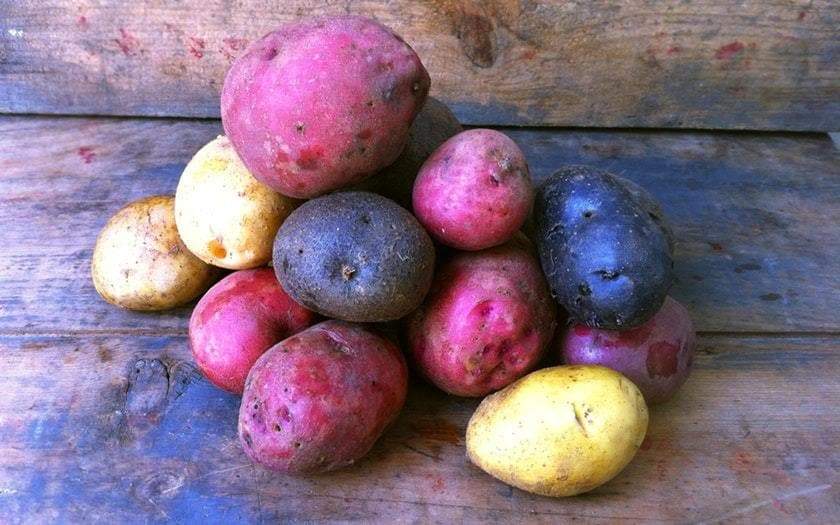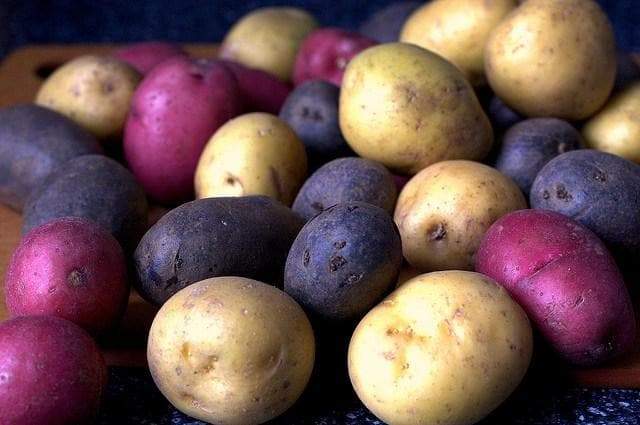
Potato (Color mix) Blue,Red,Yellow,White,
Most orders are processed by the next day
Select your desired size and/or color from the available options.
All of our Potatoes are organically Grown, untreated and ready to use in the kitchen or plant in the garden! -
- Organic, Untreated, Excellent
- organic Untreated, Ready to eat or grow
Color Mix Seed Potato Mix ,Speciality Potato,Blue,Red,Yellow,White, Excellent .
Yukon Gold Best seller and an excellent keeper! Attractive, smooth, thin yellow skin, shallow eyes, yellow flesh and uniform yields. If you like your fried potatoes golden brown, Yukon Gold will almost turn that color by themselves. However, with Yukon Gold, your mashed potatoes are golden and beautiful to both the eye and the taste. When first harvested, Yukon Gold shows unique pink eyes not seen in other yellow varieties. They are best when home grown!
All Blue Brighten your meals with this tasty blue-purple potato! With deep blueish-purple skin and flesh that almost appears purple, here is another potato to brighten your table and your favorite potato salad. A family favorite for making awesome french fries or mashed potatoes. Abundant yields of medium sized oblong tubers.
Russet Easy and adaptable red potato for home gardening. Most likely the easiest and most adaptable red potato there is to grow, not to mention the consistent flavor! Attractive deep red skin and eyes, white flesh. The tuber of choice for new potatoes or fresh eating. Red Pontiac came from Florida in 1945 so it grows well in both the South and North regions.
All Red To say this potato is excellent, is an insult! Completely red! Both inside and out. A fun to cook with and delicious tasting potato
Soil, Planting, and Care
Plants produce potatoes of various shapes and sizes.
Shapes and sizes of homegrown potatoes will vary even from the same plant.
Potatoes are cool-season crops and can survive light frosts. Plant as soon as soil is workable in early spring. Potatoes need fertile, well-drained soil that’s loose and slightly acid (pH 5.8 to 6.5). Hard, compacted soil produces misshapen tubers. Amend heavy clay soil the fall before planting by working organic matter into planting beds. Potatoes form tubers 4 to 6 inches below the soil surface. When stems reach 8 inches tall, draw soil up and around plants, covering half of lower stems. Repeat the process two to three weeks later. Potatoes exposed to sunlight turn green, which causes flesh to taste bitter. Keeping tubers covered prevents greening
IF YOU MUST DELAY PLANTING: If you need to store your potato before planting them, keep the bag in a cool (40-50°F), well-lit place. The eyes may begin to form chubby little sprouts, but this just indicates that they are ready to grow. Do not remove these sprouts. If the potatoes are stored in a warm, dark place, however, they will make long pale shoots, which will weaken the plants.
CULTURE:
Potatoes grow best in well-drained, fertile soil with a pH of 6.0-7.0. Cut tubers into pieces roughly 1 1/2-2 oz. (1-1 1/4" diameter) each, with at least one "eye" per piece. Small tubers may be planted whole. Potatoes can be planted in early to mid-spring as they tolerate cool soil and moderate frost. Plant seed pieces 2-3" deep, 12" apart, in rows 30-36" apart. Plants will emerge 2-3 weeks later. When the plants are 6-8" tall, hill them by mounding soil from each side of the row about 4" high along the base of the plants to protect developing tubers from greening. Repeat hilling process as plants grow until hills are about 12" high.
DISEASES:
The best disease control is fertile soil, crop rotation, and consistent moisture.
INSECT PESTS:
Row covers work well to exclude insect pests such as Colorado potato beetles, aphids, and leafhoppers. Otherwise, scout for yellow-orange potato beetle eggs on undersides of leaves and crush them; manually remove and dispose of larvae and adults. Potato beetles can also be controlled with a spinosad insecticide.
HARVEST:
Small, "new" potatoes can be harvested beginning about 7-8 weeks after planting. Main crop tubers are harvested in fall. After foliage has died back, leave tubers in the ground for 2 weeks to set skin. Dig tubers, brush off soil, and allow skins to dry before storing. Store in a cool but not freezing (40°F/4.4°C)
LET OUR CUSTOMER SPEAK FOR US

![[Seeds] - Caribbeangardenseed](http://caribbeangardenseed.com/cdn/shop/files/gift-card-gift-card-1_1024x1024_dfa857db-9150-4315-a362-7f0bb3fb9c47_60x28.png?v=1703978838)

